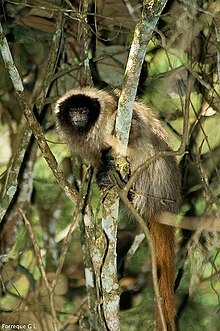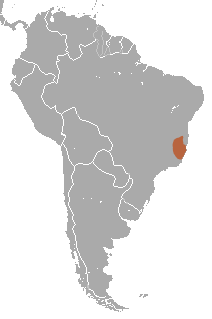Atlantic titi
| Atlantic titi | |
|---|---|
 |
|
| Atlanti titi in Domingos Martins, Brazil. | |
| Scientific classification | |
| Kingdom: | Animalia |
| Phylum: | Chordata |
| Class: | Mammalia |
| Order: | Primates |
| Family: | Pitheciidae |
| Genus: | Callicebus |
| Species: | C. personatus |
| Binomial name | |
|
Callicebus personatus (É. Geoffroy in Humboldt, 1812) |
|
 |
|
| Atlantic titi range | |
The Atlantic titi or masked titi (Callicebus personatus) is a species of titi, a type of New World monkey, endemic to Brazil.
The Atlantic titi is part of the genus Callicebus which is composed of thirteen species and sixteen subspecies. More specifically, they belong to the group Callicebus moloch which is composed of eight species and eight subspecies. Three subspecies of Callicebus personatus have been described in scientific literature: C.p. melanochir, C.p. nigrifrons, and C.p. personatus. Atlantic titis are territorial, middle-sized, cebid monkeys; usually 1–2 kg in size.C. personatus are found primarily in the humid forests east of the Andes Mountains, specifically in the coastal, inland forests of south-eastern Brazil. The states they have been documented to dwell within include Bahia, Espírito Santo, Minas Gerais, Rio de Janeiro, and São Paulo. Of all the Callicebus species, Atlantic titi monkeys have the largest geographic range except for C. torquatus, covering approximately 1,000 kilometers. They customarily share their living area with other monkeys such as the lion tamarin and spider monkey.
The three subspecies of Callicebus personatus are products of clinical differentiation (when certain portions of the population are cut off from the parental stock due to an ecological barrier such as a river and are thus completely genetically isolated from one another). Distinctions between each of the Callicebus subspecies are based on coat color. The evolution of these coat colors is termed metachromism. The pigments are produced by melanocytes which deposit the pigments into the medulla of growing hair so that the hair grows with the color of that distinct pigment. The characteristic pigment of the Callicebus is eumelanin (dark brown or black) found in the iris, skin, and hair (usually on the forehead, crown and tail).
...
Wikipedia

